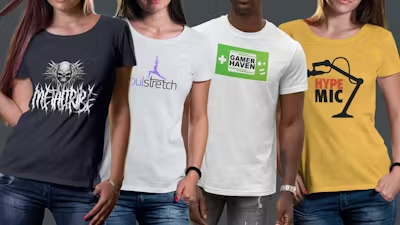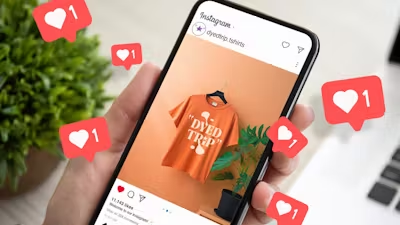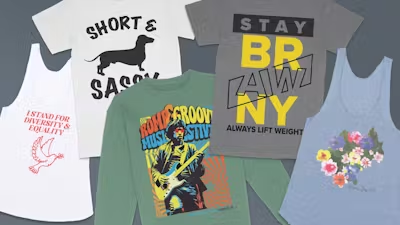Welcome to Chapter 3 of The Ultimate T-Shirt Business Success Guide.
Selecting the right t-shirt printing method is a game-changer for your business. Your choice will impact everything from product quality and production capacity to profit margins and scalability. In essence, your printing method is the backbone of your business model and operations. Often, your business model will dictate the most suitable printing technique.
In this chapter, we'll dive into the pros, cons, costs, and ideal applications of the three most popular printing techniques: screen printing, direct-to-garment (DTG), and direct-to-film (DTF) transfers. We'll also explore specialty printing and how to align the right method with your business goals, whether you're managing a traditional bulk order shop, a print-on-demand service, or a hybrid model.
Understanding these printing techniques and their alignment with your strategy is crucial for maximizing growth and profits. By the end of this chapter, you’ll be equipped to choose the t-shirt printing method that perfectly suits your business needs and sets you on the path to success. Ready to make a decision that will transform your business? Let’s get started!
Table of Contents
- Top 3 t-shirt printing methods
- Specialty printing methods
- Impact of your business model
- How to get started
- Conclusion

Top 3 t-shirt printing methods
While there are numerous t-shirt printing techniques, three methods stand out as the most popular and effective for apparel businesses - screen printing, direct-to-garment (DTG), and direct-to-film (DTF) transfers. Understanding the pros, cons, costs, and applications will help you determine the best approach to meet your business needs.
Screen printing: the go-to for traditional bulk orders
Screen printing has been the dominant t-shirt printing method for decades. The process involves pushing ink through a mesh stencil onto the fabric. Each color in the design requires its own custom screen, making screen printing most cost-effective for large bulk orders with a limited color palette.
Printing Cost
The primary cost factors are the setup expenses of creating screens for each color and the number of prints needed to spread out that initial investment. More colors mean more screens, driving up startup costs. However larger order volumes reduce the per-unit price. Ideal for big batches printed at once.
DIY Startup Cost
Launching a DIY screen printing business requires significant upfront investment. At a minimum, you need equipment like washout booths, exposure units, presses, and flash dryers. Mastery of the craft also takes hands-on training and practice. That's why many entrepreneurs outsource printing but handle design and order fulfillment themselves.

DTG (direct-to-garment): for third-party POD
Direct-to-garment (DTG) printing is a digital process that uses specialized inkjet technology to print designs directly onto fabric. DTG excels at complex, multi-color prints with photorealistic quality and detail. It avoids the setup costs of screens, making it suitable for small batch orders.
Printing Cost
A major benefit of DTG is the low setup cost since no screens are required. It is typically charged at a flat per-print rate, which can cut into margins but avoids production responsibilities. The tradeoff for outsourcing DTG is simplified operations.
DIY Setup Cost
Commercial DTG printers run tens of thousands of dollars. Ongoing maintenance and ink expenses are also hefty for top-tier machines. While more affordable options exist, print quality is often subpar. DTG has a substantial learning curve as well. For dedicated entrepreneurs, the investment can pay dividends long-term.

DTF (direct-to-film) transfers: For DIY print-on-demand and hybrid models
Direct-to-film (DTF) transfers represent a revolutionary heat transfer method for t-shirt printing. DTF prints are made by inkjet printing designs onto a specialized film coated with a polymer adhesive layer. When heat pressed onto fabric, this adhesive layer activates to produce a crisp, vibrant print that bonds with the fibers.
DIY Setup Cost
The startup costs for DTF transfers are very low, compared to set for other methods. All you need is a quality heat press, a supply of blank garments, and custom DTF transfers. The printed transfers can be stored and pressed as needed for fulfillment.
Comparison chart
| Screen Printing | DTG (Direct-To-Garment) | DTF (Direct-To-Film) |
|
✅ Vibrant, saturated colors ✅ Precise Pantone color matching ✅ Prints on a variety of fabric types ✅ Durable, flexible, and long-lasting ✅ Cost-effective for large orders ✅ Can use special FX inks (glow, puff, etc.) ✅ Printing in bulk allows for higher margins ❌ Number of colors increases cost ❌ Cost-prohibitive at low quantity ❌ Difficulty with gradients and photos ❌ Small details can get lost ❌ Limited to standard print locations |
✅ Detailed, full-color prints ✅ Photo-realistic designs and gradients ✅ Good for print-on-demand services ✅ Soft hand feel compared to others ❌ Difficulty with color accuracy ❌ Cost-prohibitive at high quantity ❌ Limited to cotton & some cotton blends ❌ Limited to CMYK colors ❌ Can fade with washing over time |
✅ Vibrant, high-quality full-color prints ✅ Reproduces detailed, intricate designs ✅ Works on dark and light colors ✅ Almost any kind of fabric type ✅ Durable, flexible, and long-lasting ✅ Can work for unique print locations ✅ Easy to heat press ❌ Limited to CMYK colors only |
|
Best for: large batch orders, simple designs, limited colors. Concert tees, logos on company uniforms, promotional shirts. It's the go-to when you need exact Pantone colors or special FX inks, something only screen printing can deliver. |
Best for: multi-colored, detailed designs on a small batch of t-shirts or for print-on-demand orders. Useful for selling custom prints, small-run event t-shirts, or personalized gifts. A decent alternative to screen printing for photographic prints and designs that fade softly into the shirt. |
Best for: intricate, full-color designs on various garments, including dark and synthetic materials. Photo-realistic prints, brands requiring high quality, businesses requiring durability. Ordering printed DTF transfers to heat press at home is an easy, low-cost way to start selling DIY custom apparel. |
Specialty printing methods
While screen printing, DTG, and DTF transfers handle most t-shirt printing needs, some businesses utilize specialized techniques for unique applications:
Sublimation employs heat to bond fabric dyes into polyester materials permanently. This allows for stunning photorealistic, all-over prints. However, sublimation only works on synthetic fabrics. Most sublimation is done with large commercial heat presses to achieve full coverage. The startup costs for equipment and sublimation inks are high.
Cut vinyl involves physically cutting designs from specialty vinyl materials using electronic plotters. These are then heat-pressed onto garments. This allows creative embellishments like glitter, foil, iridescent, and more. However, the manual cutting and weeding process is labor intensive. Complex designs with curves and details prove impractical.
Embroidery uses stitching to apply logo and branding elements with a premium, tactile quality. Ideal for headwear, bags, and upscale apparel. On t-shirts, embroidery is generally constrained to the left chest or sleeve areas. The machinery carries high startup costs.
These specialty techniques can complement major printing methods for unique products. Combining approaches opens creative options. However, specialty printing remains less versatile and cost-effective than screen printing, DTG, and DTF for most t-shirt business models.
For more on print methods, you can read our full comparison of the various types of t-shirt printing.

Impact of your business model
The type of t-shirt printing you choose is intrinsically tied to your business model and goals. Let's examine how three common models align with specific techniques:
Third-party print-on-demand (POD) with online marketplaces
For beginners, platforms like Redbubble, TeePublic, and Amazon Marketplace offer a turnkey POD solution. You simply upload designs, and they handle printing and fulfillment, predominantly using direct-to-garment (DTG). The ease of setup is a major perk, but profit margins suffer due to their fees. You also sacrifice quality control in exchange for simplicity and low startup costs.
Traditional bulk orders for retail and wholesale
Established brands planning brick-and-mortar shops or wholesale order bulk shirts from a screen printing company. You design the artwork and place large orders of simple designs. The printer handles production using their professional equipment. This requires significant upfront costs for bulk blanks and printed inventory. But profit margins can be higher on large order volumes. The tradeoff is committing to printed bulk inventory that carries risk.
DIY POD with an e-commerce website
The DIY print-on-demand model enabled by DTF transfers is ideal for entrepreneurs and small teams. With low startup costs, you can operate from a home or office workspace, maintaining complete control over your brand and production. It also provides immense creative freedom to use specialty fabrics and print placements. Moreover, a DIY approach allows you to sell through third-party marketplaces for expanded reach. You control order volume based on your production capacity and enjoy higher profit margins. As your business grows, this model easily scales to support increasing demand.
The key is matching your goals to the printing approach that best supports your ideal business model. Keep the pros, cons and costs in mind. With the right strategic fit, your print methodology can help maximize success.
If you haven't read Chapter 2, we provide a step-by-step guide to making a t-shirt business plan.
How to get started
Launching your own print-on-demand t-shirt business using DTF transfers provides immense advantages over outsourcing production. Follow these key steps to get your DIY POD operation up and running:
Set up an e-commerce storefront to display and sell your designs. This could be your own website or listing products through a digital marketplace. Ensure your online store looks professional, displays products attractively, and functions smoothly for customers.
Have a supply of blank t-shirts and other apparel on hand in the styles, colors, and sizes you plan to offer. Since DTF works on virtually any fabric, you can get creative with material choices like tri-blends, soft polyesters, and unconventional cuts to make your product line truly unique.
Order pre-printed DTF transfers for each of your designs. These can be purchased on gang sheets with multiple prints to be more cost-effective. Keep your DTF transfers organized and easily accessible for production. The prints remain vibrant for years before pressing.
Set up a dedicated workspace with a high-quality heat press and any other necessary supplies. While you don't need a large area, your setup should allow you to press shirts with your transfers smoothly and prepare orders for shipping. Stay organized.
Have shipping materials like boxes, tissue paper, stickers, and prepaid labels stocked and ready to go. When orders come in, you want to fulfill them swiftly. Package up customized shirts and get them shipped out to excited customers ASAP.
By following these steps, you can launch a lean POD business with low startup costs. The DIY approach gives you better quality control, direct customer connection, and higher profits. Once you have your system in place, fulfilling orders is easy. With DTF transfers, small brands can turn creativity into successful commerce.

Conclusion
Selecting the optimal t-shirt printing method is a strategic decision that shapes your business model, operations, and profitability. The printing method you select today doesn't have to define your business forever. But it should propel you down the right path.
Third-party POD platforms offer simplicity for beginners but limit margins. Screen printing enables high volumes for wholesale brands but requires a significant upfront investment. A DIY POD model with DTF transfers provides control and versatility for e-commerce shops on a budget.
Whatever approach you choose, let it be a catalyst, not a constraint. The ideal printing method aligns with your goals to help you adapt and scale. As your business evolves, reevaluate your model and technology needs. Let it empower you to turn creativity into commercial success as you continue your entrepreneurial journey in the dynamic t-shirt industry.
Continue to Chapter 4: Choosing a Niche For Your T-shirt Business








































